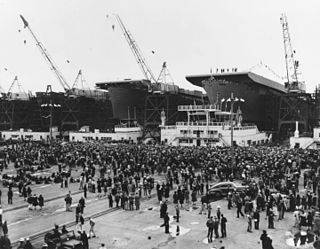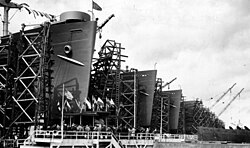
Vigor Shipyards is the current entity operating the former Todd Shipyards after its acquisition in 2011. Todd Shipyards was founded in 1916, which owned and operated shipyards on the West Coast of the United States, East Coast of the United States and the Gulf. Todd Shipyards were a major part of the Emergency Shipbuilding Program for World War II.

The Kaiser Shipyards were seven major shipbuilding yards located on the United States west coast during World War II. Kaiser ranked 20th among U.S. corporations in the value of wartime production contracts. The shipyards were owned by the Kaiser Shipbuilding Company, a creation of American industrialist Henry J. Kaiser (1882–1967), who established the shipbuilding company around 1939 in order to help meet the construction goals set by the United States Maritime Commission for merchant shipping.

The four Richmond Shipyards, in the city of Richmond, California, United States, were run by Permanente Metals and part of the Kaiser Shipyards. In World War II, Richmond built more ships than any other shipyard, turning out as many as three ships in a single day. The shipyards are part of the Rosie the Riveter/World War II Home Front National Historical Park, whose Rosie the Riveter memorial honors the shipyard workers. Shipyard #3 is listed on the National Register of Historic Places and is a California Historical Landmark # 1032.

The Emergency Shipbuilding Program was a United States government effort to quickly build simple cargo ships to carry troops and materiel to allies and foreign theatres during World War II. Run by the U.S. Maritime Commission, the program built almost 6,000 ships.

The Seattle-Tacoma Shipbuilding Corporation was an American corporation which built escort carriers, destroyers, cargo ships and auxiliaries for the United States Navy and merchant marine during World War II in two yards in Puget Sound, Washington. It was the largest producer of destroyers (45) on the West Coast and the largest producer of escort carriers of various classes (56) of any United States yard active during World War II.

Willamette Iron Works was a general foundry and machine business established in 1865 in Portland, Oregon, originally specializing in the manufacture of steamboat boilers and engines. In 1904, the company changed its name to Willamette Iron and Steel Works, under which name it operated continually until its close in 1990.

The Bethlehem-Fairfield Shipyard of Baltimore, Maryland, was a shipyard in the United States from 1941 until 1945. Located on the south shore of the Middle Branch of the Patapsco River which serves as the Baltimore Harbor, it was owned by the Bethlehem Shipbuilding Company, created by the Bethlehem Steel Corporation of Bethlehem, Pennsylvania, which had operated a major waterfront steel mill outside Baltimore to the southeast at Sparrows Point, Maryland in Baltimore County since the 1880s.
Felix Hathaway was an American carpenter and pioneer in what became the state of Oregon. A native of New England, he settled in the Oregon Country where he helped construct the first American-built ship in what became the state of Oregon. His home was used for the first meeting of the Provisional Legislature of Oregon in 1844.

The Kaiser Company , commonly known as the Swan Island Shipyard, was a shipyard on Swan Island in Portland, Oregon, United States. It was constructed by the industrialist Henry J. Kaiser in 1942 as part of the U.S. Maritime Commission's Emergency Shipbuilding Program in World War II. The Swan Island yard was one of three Kaiser Shipyards in the Portland area, along with the Oregon Shipbuilding Corporation and the Vancouver Shipyard.
The G. M. Standifer Construction Company was an American company that built three shipyards on the Columbia River for the World War I effort, one in Oregon and two in Washington, all within spitting distance of each other. After the war it maintained its original yard in North Portland, Oregon. The North Portland yard, and one of the Vancouver, Washington yards produced wooden ships. The other Vancouver yard, located just west of what was then the Spokane, Portland and Seattle Railway bridge produced steel-hulled ships. The Portland yard was located about a mile to the west, just downstream from the BNSF bridge. Both Vancouver yards were closed in 1921.

The Ocean ships were a class of sixty cargo ships built in the United States by Todd Shipyards Corporation during the Second World War for the British Ministry of War Transport under contracts let by the British Purchasing Commission. Eighteen were lost to enemy action and eight to accidents; survivors were sold postwar into merchant service.

Swan Island is located on the Willamette River about 4.5 miles (7.2 km) downriver from downtown Portland, Oregon, United States. Although presently connected to the Willamette's east bank by land fill, it existed as a river island under natural conditions.

The Kaiser Company , commonly known as the Vancouver Shipyard, was an emergency shipyard constructed along the Columbia River in Vancouver, Washington, to help meet the production demands of the U.S. Maritime Commission in World War II. The shipyard was one of three Kaiser Shipyards in the Pacific Northwest, along with the Oregon Shipbuilding Corporation and the Swan Island Shipyard across the Columbia in Portland, Oregon. The Vancouver Yard began production in early 1942 and totaled nearly 200 acres (81 ha). It produced vessels of five different types, with Casablanca-class escort carriers being its biggest production line.

Albina Engine & Machine Works was a shipyard along the Willamette River in Portland, Oregon, United States. It was located in the Albina area of Portland along N. River Street and N. Loring Street. Albina Engine & Machine Works was founded in 1904. The shipyard produced a number of freighters during World War I, but operated mainly as a repair yard during the 1920s and 1930s. The Albina yard expanded its workforce and production during Portland's World War II shipbuilding boom. It specialized in producing subchasers, vessels designed to combat German U-boats. Albina Engine & Machine Works also built Landing Craft Support boats and cargo ships. Business declined in the post-war years, and Albina Engine & Machine Works was sold to the Dillingham Corporation around 1971.














